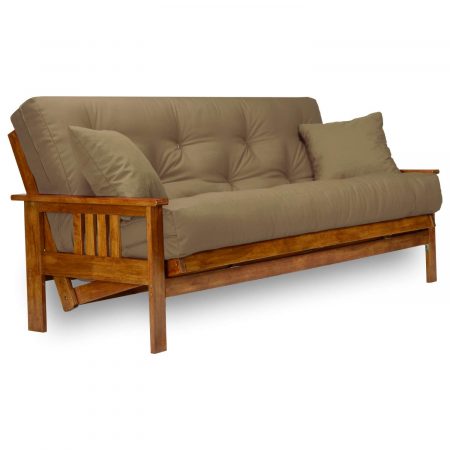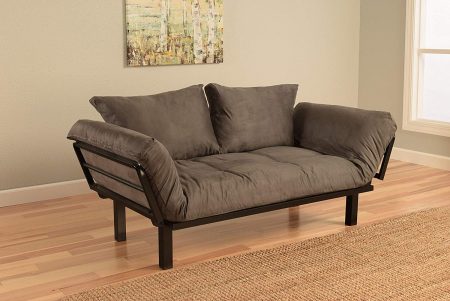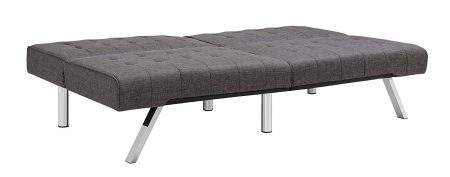Buying Guide – How to Shop for a Futon
The term ‘futon’ refers to a sleep system consisting of a padded mattress and an adjustable frame. Futons originated in Japan but have gained worldwide popularity for the past few decades, particularly in the U.S.
Some people use futons as their primary bedding surface, but they most commonly serve as guest beds to accommodate overnight sleepers. Futons are regularly used in dorm rooms, as well.
In terms of thickness, a futon mattress may measure anywhere from 3″ to 10″, though most have profiles that fall between 5? and 9?. Futons may be padded with different materials, such as cotton and foam; some models contain springs, as well.
Futon frames come in different styles too, including bifold, trifold, and loveseat options. Futon mattresses and frames usually have lower price-points compared to standard mattresses and bed, but their lifespans are shorter than average.
This guide will discuss different styles and designs of futon mattresses and frames, as well as pros and cons of different futon models and important considerations for first-time buyers.
Futon Frames and Mattresses: Common Styles and Designs
In Japan, futons have traditionally been placed on tatami mats that allow sleepers to rest on the floor. However, most U.S. futon owners use futon frames instead. The vast majority of futon frames are made from wood, metal, or a combination of wood and metal. Common futon frame designs include the following:
- Bifold: Bifold frames resemble sofas when placed in the upright position with the futon mattress folded in half. The frame can also be placed in a down position with the mattress completely flat. This design allows the frame to provide sleeping and non-sleeping surfaces. Bifold frames can be used with futon mattresses of any thickness.
- Trifold: Like the bifold frame, the trifold frame can function as a non-sleeping sofa as well as a bed. These frames feature three distinct sections – a back, a seat, and a footrest – with a mattress that folds in two places. Trifold frames are normally used with thinner futon mattresses.
- Loveseat: A loveseat futon frame can be placed in an upright position, which resembles a sofa, or a flat position for sleeping. Additionally, loveseat frames can also be placed in a lounging position that is optimal for reading or watching television.
- Bunk bed: Some bunk bed designs come with one or two elevated beds over a bifold or loveseat futon frame. This style is especially popular in dorm rooms.
In addition to the frame design, futon frames also vary in terms of style. A traditional futon frame resembles a sofa with arms and a back, while armless frames have a back only. Armless frames may be more suitable for taller sleepers who have a hard time fitting between the arms of traditional frames.
Once shoppers have determined their preferred frame design and style, they will be ready to select a futon mattress. The most common types of futon mattresses include the following:
- Foam: The mattress consists of two or more polyfoam layers.
- Cotton: The mattress primarily (or, in some cases, exclusively) contains cotton padding layers. Cotton futon mattresses are often thinner than other models.
- Foam and cotton: Most foam/cotton futon mattresses include a top layer of cotton padding and a polyfoam base, but the order may be swapped too.
- Innerspring: Though fairly rare, some futon mattresses contain a foam or cotton comfort layer and a coil-based support core. Innerspring futon mattresses tend to be on the thicker side.
In addition to the materials, futon mattresses vary by the following factors:
- Available sizes: Twin, Full, and Queen are the most common futon mattress sizes. Other sizes that are commonly available for standard mattresses, such as Twin XL or King/California King, are rare for futon mattresses.
- Firmness: Due to their low profiles and thinner padding layers, the majority of futon mattresses fall between ‘Medium Firm’ and ‘Firm’. Using the 1-10 firmness scale, this means most models are considered 6 to 8.
- Thickness: Most futon mattresses measure between 5? and 9? thick. Innerspring mattresses tend to be the thickest option while cotton and foam/cotton models are usually the thinnest.
- Cover: To ensure the sleep surface remains clean and hygienic, most futon mattresses come with removable cotton and/or polyester covers that can be washed and dried in conventional machines.
- Price: Most futon mattresses range in price from $100 to $300, depending on the construction and size. Innerspring futon mattresses tend to be the most expensive options, while those with mostly cotton padding are normally the cheapest.
Next, we’ll compare different futon mattress types based on customer and owner ratings.
Pros and Cons of Futon Mattress Types
The tables below include performance and sleeper ratings for the four most common futon mattress types. Our ratings are based on verified customer and owner experiences, as well as intensive product research and analysis. The first table includes durability, pressure relief, temperature neutrality, and other performance factors.



